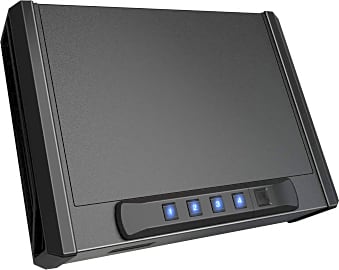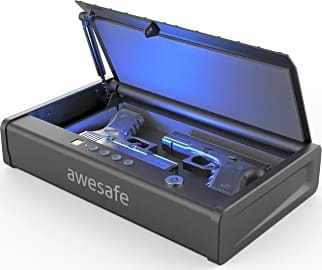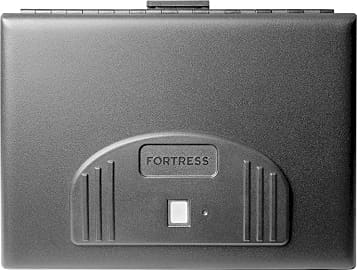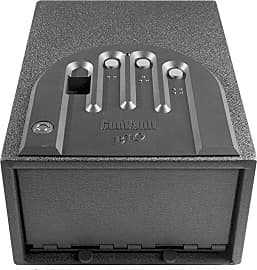The 10 Best Biometric Safes

This wiki has been updated 39 times since it was first published in March of 2015. Forget about stashing valuables in the freezer, a fake can of beans, or behind the toilet tank — crooks always look there first, and they can make it hard to quickly access what you need. Instead, go high-tech. Keep your cash, jewelry, backup data, important documents, and firearms shielded from prying hands with one of these biometric safes, each of which requires fingerprint recognition to open. When users buy our independently chosen editorial recommendations, we may earn commissions to help fund the Wiki.
Editor's Notes
December 02, 2020:
In this update we removed the Viking Security Fingerprint due to availability concerns, and got rid of the Vaultek MX Wi-Fi High Capacity because its price was unjustifiably high for its size.
We added the RPNB Quick Access, which can be opened in four different ways, including the classic biometric option and three manual methods. We also added the wildly popular Awesafe Lock, which has an interior light that triggers when you open the vault and is made of non-welded steel so that it has no easily exploitable weak points.
Many, but not all, of the options featured on this list are specifically meant for storing firearms. If you're looking for a safe that satisfies this sole purpose, take a look at the best biometric gun safes, too, so you don't miss any strong options. If, on the other hand, you're more interested in storing valuables, you might want to check out our list of digital safes or, if you don't plan on moving anytime soon, the best biometric wall safes.
June 21, 2019:
Poor performance and availability issues sent a pair of models packing for this ranking, as the HomCom model became something of a ghost, and the Stack-On model had significant problems recognizing fingerprints. We've added a quartet of entries to this new list, including the SentrySafe QAP1BE thanks to its incredibly reliable scanner and its availability in two sizes (one meant for a single handgun, the other for a pair of pistols).
We also tried to give priority to safes that offered additional means of entry, as biometric scanning still struggles to maintain a baseline of effectiveness, especially in high-stress situations like a home invasion, which could cause too much sweat to accumulate on the hands for lower-quality readers to get the job done. That does pose an added security risk for some users, though, who might want their living fingerprint to be the only means of entry. So, for some this will be a matter or preference, but since biometric safes are about a combination of access speed and security, we believe a combination to be a smart idea (unless, of course, the scanner in question has proven itself in a multitude of situations to be effective).
Give Thieves The Finger
Furthermore, if a safe's sensor utilizes an optical radio frequency for its pattern recognition, these penetrate past layers of dead tissue until they reach a living layer.
Biometrics is a pretty broad term; it can refer to any means by which a person's biological markers or behaviors betray their identity. It can include anything from your fingerprints to your footprints, from your iris to the physical ticks that tell your poker opponents that you're bluffing (though technically, your opponent would have to be a computer for the data recorded to be considered biometric).
It wasn't long ago that these kinds of devices existed purely in the realm of science fiction, but our digital technologies have come so far in such a relatively short period of time that we now have biometric scanning to unlock our cell phones and computers.
For a safe, there could be no more secure method of ensuring the protection of the precious contents within. Even without biometric protections, the weight of a safe, the thickness of its metals, and the security of its locking mechanisms and seals make it a perfect place to store whatever you don't want stolen.
A biometric safe adds a crucial layer of protection, however, by requiring the presence of your fingerprint to unlock its door. It does so not by taking an image of your fingerprint that could be hacked and recreated by a professional safe-cracker. Instead, it picks up on a given number of unique traits in your fingerprint that make it unlike any other, and then immediately translates that information into a binary code, the presence of which unlocks the safe like a combination.
Now, you might well worry that an intruder could simply cut off your finger and use it to gain access to your safe, but it turns out that the scanners that safe manufacturers employ are activated–woken up, if you will–by the small amounts of electrical charge running through your fingertips. It's the same electrical charge that Scientologists measure during an audit, and it's always there (unless the finger in question is disembodied).
Furthermore, if a safe's sensor utilizes an optical radio frequency for its pattern recognition, these penetrate past layers of dead tissue until they reach a living layer. That way, if you have dry, chapped hands and fingers, your safe will still unlock, but if there's no live tissue to speak of (the disembodied finger) the safe stays shut. Pretty gruesome, right?
Safety In Numbers
When choosing among the safes on our list, you'll notice that the majority of the options we present operate in much the same way. The biometric scanners are almost all uniform, even though there are a few other styles of scanner on the market.
The safes on our list all employ the most secure forms of scanning technology, and they all have thick, heavy metal walls and doors designed to keep your stuff safe from saws and pry bars. The differences among them, then, the aspects upon which you're going to make your decision, are primarily their sizes and their additional locking options.
Bigger safes tend to be more expensive, but you can't rightly put a price on this level of security.
A few of these safes rely solely on their biometric scanners to open their doors. You simply lay your finger on the scanner and the door unlocks. Others have additional security measures, like digital combination locks with keypads of varying number quantities. If you don't think you're going to need quick access to your safe (like you would to access a gun in the event of an emergency or home invasion, for example), that extra layer of security is probably a good idea.
As far as the size question goes, you're going to have to take a look at all the important documents and items you wish to protect, and figure out how many cubic feet you'll need to store them. Bigger safes tend to be more expensive, but you can't rightly put a price on this level of security.
Finally, there's an additional question of access. The safes on this list can store different numbers of fingerprints depending on which model you pick up. Sometimes, this makes for a nice fail-safe if you have a cut on the finger you'd normally use for recognition. By simply programming in a backup finger, you can enter your safe with ease. This also means you can program your safe to open when touched by a spouse or anyone else to whom you might want to give access, as long as the safe can store the data.
Forgotten Dreams Rekindled
While it's true that biometric scanning has only recently jumped off the science fiction page and into our lives, human beings have long used their fingerprints and hand prints as a means of identifying themselves.
Archeologists have discovered fingerprints on pottery, seals, and clay tablets from ancient Babylonia, as well as on clay Babylonian legal documents into which the parties would depress their thumbprints as a signature. Ancient Egypt, Greece, and China all have similar historical findings.
Ancient Egypt, Greece, and China all have similar historical findings.
In the Chauvet-Pont-d'Arc Cave in southern France in 1994, three speleologists discovered what are widely considered to be the oldest cave paintings known to man. The cave is the subject of a beautiful documentary by Werner Herzog entitled Cave of Forgotten Dreams, and in it, one of the archeologists and art historians explains the presence of a peculiar marking at the cave entrance and elsehwere throughout the cave.
As she walks Herzog through the space, she points out what look like little red smudges covering one rock by the cave entrance, and appearing next to a large number of the paintings, as well. Upon close inspection, we see that these are actually hand prints, a kind of signature left by the artist some 32,000 years ago.
Many millennia later, at the turn of the 20th century C.E., Juan Vucetich, an Argentinian police officer, began to use fingerprints as a means of identifying criminals who had been present at the scene of a crime. His work, along with several published theories that informed him along the way, would go on to create the fingerprinting technologies that still dominate the landscape of forensic science, and which are the primary drivers behind biometric technology.















